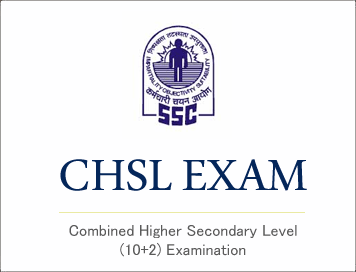(Syllabus) SSC Combined Higher Secondary Level (10+2) (CHSL Tier-1)

(Syllabus) SSC Combined Higher Secondary Level (10+2) (CHSL Tier-1)
Tier-I (Computer Based Examination-Objective Type):
|
Dates of Computer Based Examination (Tier-I) |
Part |
Subject (Not in sequence) |
Number of Questions/ Maximum Marks |
Time Duration(For all four Parts) |
|
01-07-2019 to 26-07-2019 |
I |
English Language (Basic Knowledge) |
25/ 50 |
60 Minutes (80 Minutes for candidates eligible for scribes as per para 8.1 and 8.2) |
|
II |
25/ 50 |
|||
|
III |
Quantitative Aptitude (Basic Arithmetic Skill) |
25/ 50 |
||
|
IV |
25/ 50 |
13.5.1 The Tier-I Examination will consist of Objective Type, Multiple choice questions only. The questions will be set both in English & Hindi for Part-II, III & IV.
13.5.2 There will be negative marking of 0.50 marks for each wrong answer.
13.5.3 Answer Keys, in due course after the Computer Based Examination, will be placed on the website of the Commission (https://ssc.nic.in). Any representation regarding answer keys received within the time limit fixed by the Commission at the time of uploading of the answer keys, will be scrutinized and the decision of the Commission in this regard will be final. No representation regarding Answer keys shall be entertained, afterwards.
13.5.4 Marks scored by candidates in Tier-I will be normalized by using the formula published by the Commission through Notice No: 1-1/2018- P&P-I dated 07-02-2019 and such normalized scores will be used to
determine final merit and cut-off marks.
Indicative Syllabus for Computer Based Examination (Tier-I):
English Language:
Spot the Error, Fill in the Blanks, Synonyms/ Homonyms, Antonyms, Spellings/ Detecting mis-spelt words,Idioms & Phrases, One word substitution, Improvement of Sentences, Active/ Passive Voice of Verbs, Conversion into
Direct/ Indirect narration, Shuffling of Sentence parts, Shuffling of Sentences in a passage, Cloze Passage, Comprehension Passage.
General Intelligence:
It would include questions of both verbal and non-verbal type. The test will include questions on Semantic Analogy, Symbolic operations, Symbolic/ Number Analogy, Trends, Figural Analogy, Space Orientation, Semantic Classification, Venn Diagrams, Symbolic/ Number Classification, Drawing inferences, Figural Classification, Punched hole/ pattern-folding & unfolding, Semantic Series, Figural Pattern-folding and completion, Number Series, Embedded figures, Figural Series, Critical Thinking, Problem Solving, Emotional Intelligence, Word Building, Social Intelligence, Coding and de-coding, Other sub-topics, if any Numerical operations.
Quantitative Aptitude:
Number Systems: Computation of Whole Number, Decimal and Fractions, Relationship between numbers.
Fundamental arithmetical operations: Percentages, Ratio and Proportion, Square roots, Averages, Interest (Simple and Compound), Profit and Loss, Discount, Partnership Business, Mixture and Allegation, Time and distance, Time and work.
Algebra: Basic algebraic identities of School Algebra and Elementary surds (simple problems) and Graphs of Linear Equations.
Geometry: Familiarity with elementary geometric figures and facts: Triangle and its various kinds of centres, Congruence and similarity of triangles, Circle and its chords, tangents, angles subtended by chords of a circle, common tangents to two or more circles.
Mensuration: Triangle, Quadrilaterals, Regular Polygons,Circle, Right Prism, Right Circular Cone, Right Circular Cylinder, Sphere, Hemispheres, Rectangular Parallelepiped, Regular Right Pyramid with triangular or square Base.
Trigonometry: Trigonometry, Trigonometric ratios,Complementary angles, Height and distances (simple problems only) Standard Identities like sin2?? + Cos2??=1 etc.,
Statistical Charts: Use of Tables and Graphs: Histogram,Frequency polygon, Bar-diagram, Pie-chart.
General Awareness:
Questions are designed to test the candidate?s general awareness of the environment around him and its application to society. Questions are also designed to test knowledge of current events and of such matters of everyday observation and experience in their scientific aspect as may be expected of an educated person. The test will also include questions relating to India and its neighboring countries especially pertaining to History, Culture, Geography, Economic Scene, General policy and scientific research.
For VH candidates of 40% and above visual disability, there will be no component of Maps/ Graphs/ Diagrams/ Statistical Data in the General Intelligence and Quantitative.

